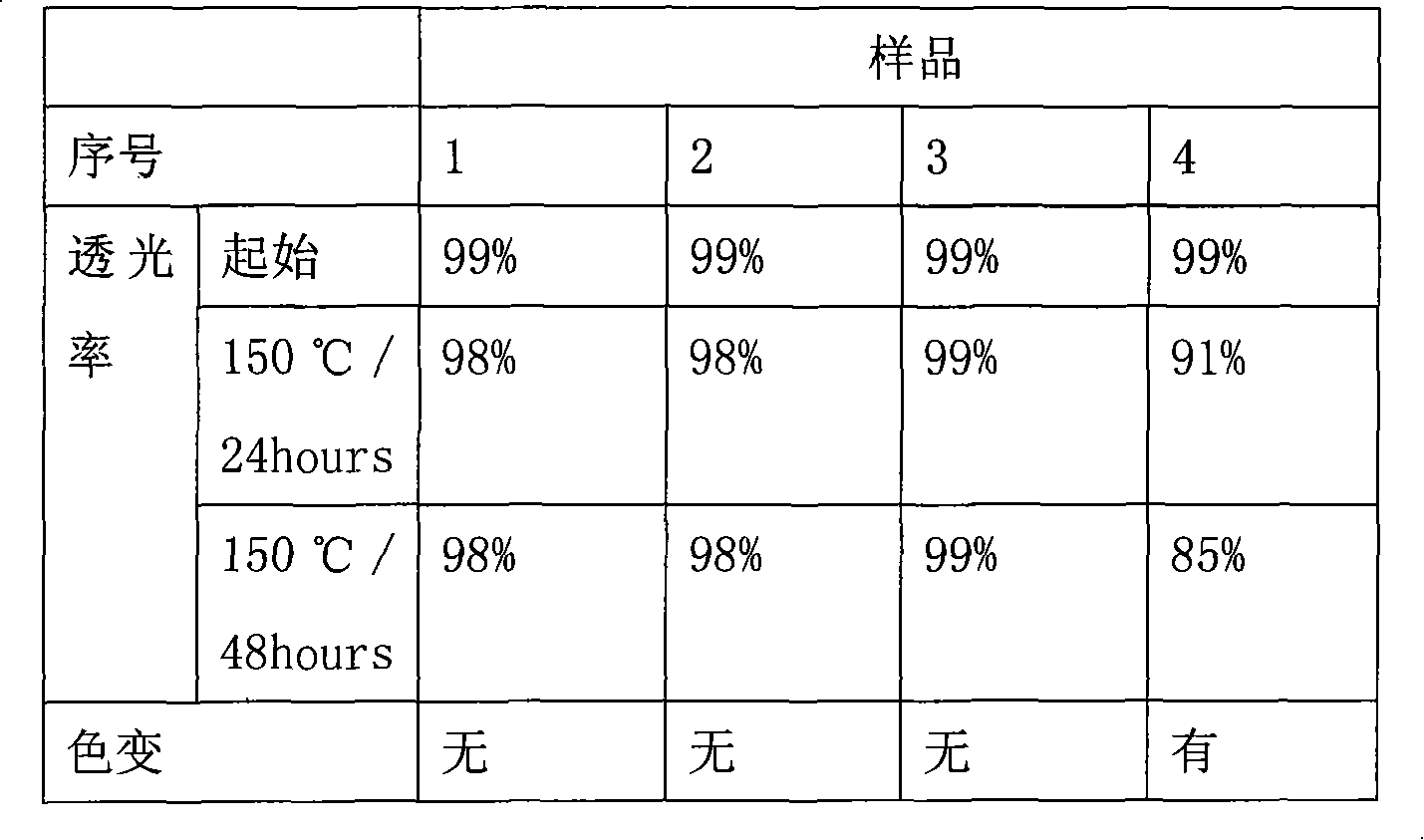Preparation and application of silica gel for LED packaging
A technology of LED encapsulation and organic silicon, which is applied in other chemical processes, chemical instruments and methods, etc., can solve problems such as a long gap, and achieve good transparency, excellent thermal aging ability, and excellent UV aging resistance.
- Summary
- Abstract
- Description
- Claims
- Application Information
AI Technical Summary
Problems solved by technology
Method used
Image
Examples
example 1
[0043] The preparation method of component A includes the following steps:
[0044] 1. Pour a certain amount of 500g toluene and 1500g water into a 10L three-necked flask, then weigh 42.3g of methylvinyldichlorosilane monomer, 294g of dimethyldichlorosilane monomer and 0.65g of trimethyl chloride Silane was mixed and dissolved in 500g of toluene, and then the mixed monomer solution was slowly added dropwise at a temperature below 25°C while stirring. Then, it was washed with water until neutral, and water, toluene and unreacted monomers were distilled off under reduced pressure to obtain a prepolymer 1.
[0045] 2. Measure the above-obtained prepolymer 1 into a three-necked flask, then add 178g octamethylcyclotetrasiloxane and 0.3g KOH, carry out catalytic equilibrium at 140-160°C for 6h, cool down, add a small amount of Trimethylchlorosilane is neutralized to neutrality, then the catalyst is removed by filtration, and the unreacted ring body and low boilers are distilled off...
example 2
[0051] The preparation method of component A includes the following steps:
[0052] 1. Pour a certain amount of 500g toluene and 1500g water into a 10L three-necked flask, then weigh 8.5g methylvinyldichlorosilane monomer, 588g dimethyldichlorosilane monomer and 0.74g dimethyldichlorosilane Vinyl chlorosilane was mixed and dissolved in 500 g of toluene, and then the mixed monomer solution was slowly added dropwise while stirring at below 25 ° C. After the dropwise addition, the reactants were measured into a separatory funnel, allowed to stand, layered, and deacidified. The aqueous layer was then washed with water until neutral, and water, toluene and unreacted monomers were distilled off under reduced pressure to obtain prepolymer 1.
[0053] 2. Measure the above-obtained prepolymer 1 into a three-necked flask, then add 0.5 g of KOH, carry out catalytic equilibrium between 140-160 ° C for 6 hours, cool down, add a small amount of trimethylchlorosilane to neutralize to neutral...
example 3
[0059] The preparation method of component A includes the following steps:
[0060] 1. Pour a certain amount of 500g toluene and 1500g water into a 10L three-necked flask, then weigh 127g diphenyldichlorosilane monomer, 294g dimethyldichlorosilane monomer and 1.0g dimethylvinyl Chlorosilane was mixed and dissolved in 500g toluene, and then the mixed monomer solution was slowly added dropwise while stirring at below 25°C. After the dropwise addition, the reactant was measured into a separatory funnel, left standing, layered, and the acid water layer was removed. , and then washed with water until neutral, and distilled under reduced pressure to remove water, toluene and unreacted monomers to obtain prepolymer 1.
[0061] 2. Measure the prepolymer 1 obtained above into a three-necked flask, then 0.5g of KOH, carry out catalytic equilibrium between 140-160°C for 6h, cool down, add a small amount of trimethylchlorosilane to neutralize to neutrality, Then, the catalyst was removed...
PUM
| Property | Measurement | Unit |
|---|---|---|
| transmittivity | aaaaa | aaaaa |
Abstract
Description
Claims
Application Information
 Login to View More
Login to View More - R&D
- Intellectual Property
- Life Sciences
- Materials
- Tech Scout
- Unparalleled Data Quality
- Higher Quality Content
- 60% Fewer Hallucinations
Browse by: Latest US Patents, China's latest patents, Technical Efficacy Thesaurus, Application Domain, Technology Topic, Popular Technical Reports.
© 2025 PatSnap. All rights reserved.Legal|Privacy policy|Modern Slavery Act Transparency Statement|Sitemap|About US| Contact US: help@patsnap.com


